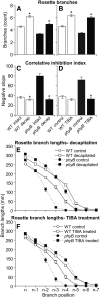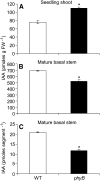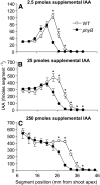Phytochrome B promotes branching in Arabidopsis by suppressing auxin signaling
- PMID: 24492336
- PMCID: PMC3938639
- DOI: 10.1104/pp.113.234021
Phytochrome B promotes branching in Arabidopsis by suppressing auxin signaling
Abstract
Many plants respond to competition signals generated by neighbors by evoking the shade avoidance syndrome, including increased main stem elongation and reduced branching. Vegetation-induced reduction in the red light:far-red light ratio provides a competition signal sensed by phytochromes. Plants deficient in phytochrome B (phyB) exhibit a constitutive shade avoidance syndrome including reduced branching. Because auxin in the polar auxin transport stream (PATS) inhibits axillary bud outgrowth, its role in regulating the phyB branching phenotype was tested. Removing the main shoot PATS auxin source by decapitation or chemically inhibiting the PATS strongly stimulated branching in Arabidopsis (Arabidopsis thaliana) deficient in phyB, but had a modest effect in the wild type. Whereas indole-3-acetic acid (IAA) levels were elevated in young phyB seedlings, there was less IAA in mature stems compared with the wild type. A split plate assay of bud outgrowth kinetics indicated that low auxin levels inhibited phyB buds more than the wild type. Because the auxin response could be a result of either the auxin signaling status or the bud's ability to export auxin into the main shoot PATS, both parameters were assessed. Main shoots of phyB had less absolute auxin transport capacity compared with the wild type, but equal or greater capacity when based on the relative amounts of native IAA in the stems. Thus, auxin transport capacity was unlikely to restrict branching. Both shoots of young phyB seedlings and mature stem segments showed elevated expression of auxin-responsive genes and expression was further increased by auxin treatment, suggesting that phyB suppresses auxin signaling to promote branching.
Figures





References
-
- Arney SE, Mitchell DL. (1969) The effect of abscisic acid on stem elongation and correlative inhibition. New Phytol 68: 1001–1015
-
- Balla J, Kalousek P, Reinöhl V, Friml J, Procházka S. (2011) Competitive canalization of PIN-dependent auxin flow from axillary buds controls pea bud outgrowth. Plant J 65: 571–577 - PubMed
-
- Ballaré CL. (1999) Keeping up with the neighbours: phytochrome sensing and other signalling mechanisms. Trends Plant Sci 4: 97–102 - PubMed
-
- Bennett T, Leyser O. (2006) Something on the side: axillary meristems and plant development. Plant Mol Biol 60: 843–854 - PubMed
Publication types
MeSH terms
Substances
LinkOut - more resources
Full Text Sources
Other Literature Sources
Molecular Biology Databases

